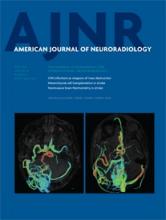Abstract
BACKGROUND AND PURPOSE: The accuracy of automatic tissue segmentation methods can be affected by the presence of hypointense white matter lesions during the tissue segmentation process. Our aim was to evaluate the impact of MS white matter lesions on the brain tissue measurements of 6 well-known segmentation techniques. These include straightforward techniques such as Artificial Neural Network and fuzzy C-means as well as more advanced techniques such as the Fuzzy And Noise Tolerant Adaptive Segmentation Method, fMRI of the Brain Automated Segmentation Tool, SPM5, and SPM8.
MATERIALS AND METHODS: Thirty T1-weighted images from patients with MS from 3 different scanners were segmented twice, first including white matter lesions and then masking the lesions before segmentation and relabeling as WM afterward. The differences in total tissue volume and tissue volume outside the lesion regions were computed between the images by using the 2 methodologies.
RESULTS: Total gray matter volume was overestimated by all methods when lesion volume increased. The tissue volume outside the lesion regions was also affected by white matter lesions with differences up to 20 cm3 on images with a high lesion load (≈50 cm3). SPM8 and Fuzzy And Noise Tolerant Adaptive Segmentation Method were the methods less influenced by white matter lesions, whereas the effect of white matter lesions was more prominent on fuzzy C-means and the fMRI of the Brain Automated Segmentation Tool.
CONCLUSIONS: Although lesions were removed after segmentation to avoid their impact on tissue segmentation, the methods still overestimated GM tissue in most cases. This finding is especially relevant because on images with high lesion load, this bias will most likely distort actual tissue atrophy measurements.
ABBREVIATIONS:
- ANN
- Artificial Neural Network
- FANTASM
- Fuzzy And Noise Tolerant Adaptive Segmentation Method
- FAST
- FMRIB Automated Segmentation Tool
- FCM
- fuzzy C-means
- H1
- Hospital Vall d'Hebron, Barcelona, Spain
- H2
- Hospital Universitari Dr. Josep Trueta, Girona, Spain
- H3
- Clinica Girona, Girona, Spain
- WML
- white matter lesion
- © 2015 by American Journal of Neuroradiology
Indicates open access to non-subscribers at www.ajnr.org












